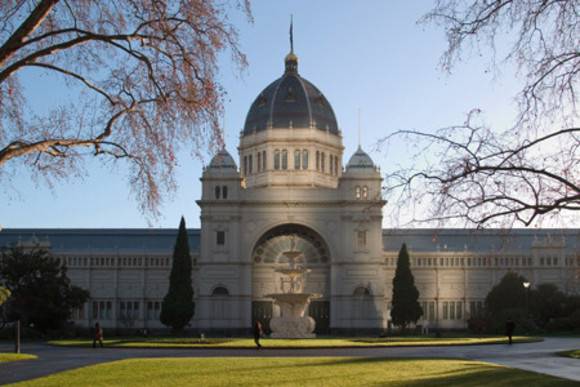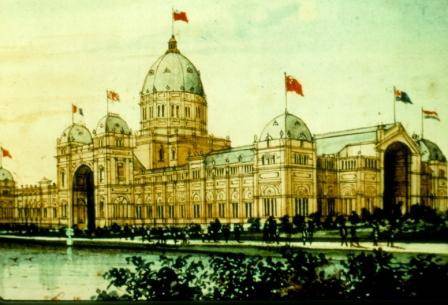| Back to search results » | Back to search page » |
|
Royal Exhibition Building & Josef Hochgurtel Fountain
LocationNicholson Street,, CARLTON VIC 3053 - Property No B0842
File NumberB0842LevelInternational |
|
Statement of Significance
What is significant? The Exhibition Building was constructed in 1879-1880 for the 1880-1 Melbourne International Exhibition. International Exhibitions were associated with the boom in manufacturing and the development of a world economy during the nineteenth century. The exhibitions provided a means of displaying contemporary achievements in the arts and commerce as well as manufacturing. A competition to design the Melbourne Exhibition Buildings was held in 1878 and was won by Reed & Barnes, Melbourne's most distinguished firm of architects at the time. The contract was awarded to prominent local builder David Mitchell. The existing building was at the centre of a group of three permanent buildings, arranged in a U-shape, and a number of temporary annexes were located to the north. Joseph Reed also designed the landscaping for the entire gardens. The decorative scheme of the interiors was carried out by John Mather, notable as an outstanding easel painter and artistic decorator. The permanent buildings from the 1880 Exhibition were used for the 1888-9 Centennial International Exhibition, held to celebrate one hundred years of European settlement in Australia. New temporary annexes were built, and for the first time, an International Exhibition was lit by electricity. The main building was used in 1901 for the opening of the first Federal Parliament, for which the interior was redecorated by John Anderson. From 1901 to 1927 the 1880 western wing was used asa temporary State Parliament while Federal Parliament occupied the Victorian Houses of Parliament. The Exhibition Building has continued to be used up to the present for a wide variety of purposes, including: for balls, concerts and fetes up to WWI; as an emergency hospital for influenza victims in 1919; by the RAAF during WWII; as a migrant reception centre after WWII; as a venue for the 1956 Olympic Games; as a motor registry and licence testing venue; for motor shows; and as a venue for school and university examinations. In July 2004 it became the first building in Australia to be added to the World Heritage List. Public Art: Exhibition Fountain by Joseph Hochgurtel in Exhibition Gardens.
The Exhibition Building is at the centre of the 26 ha Carlton Gardens, with the southern part containing the formally laid out garden which forms the forecourt to the building, while the northern section contains the Melbourne Museum and the park laid out after the completion of the 1888 Exhibition. The building is the major component of the permanent structures built for the 1880 Exhibition. The smaller wings at each end have been demolished. The building has a bluestone plinth and walls of rendered brick, now painted but originally a natural light coloured render. The timber framed roof is clad with a combination of corrugated galvanised steel and slate, embellished with decorative lead flashings and a cupola finished in gold leaf to the dome. Timber framed windows are incorporated into a clerestory within the roof space. Cast iron and rendered masonry are used to form the octagonal drum of the timber framed dome. All windows and doors are timber framed and painted. The main hall is 152.4m long, 21.9m high and 48.8m wide, and the dome is 68m high and 18.3m in diameter. The interior is a large cruciform space with a central nave and wide two storey aisles. Timber is used extensively for the columns, balcony railings, ceiling lining and floor. The wall surfaces are plastered or painted brickwork, except for the murals where a canvas base is used. All of the internal surfaces are painted in a complex scheme making extensive use of stencils. Murals also adorn the crossing at the lunettes, pendentives and in buttress panels under the dome. The basement contains offices, a museum related to the building, an archive and storage.
How is it significant? The Exhibition Building and Carlton Gardens are significant for aesthetic, architectural, historical, social, and scientific reasons at an International level.
Why is it significant? The Royal Exhibition Building is historically significant as the only major extant nineteenth century exhibition building in Australia. It is one of the few major nineteenth century exhibition buildings to survive worldwide. Together with the associated landscaped gardens the building forms one of the major surviving nineteenth century exhibition precincts in the world. The building demonstrates the wealth and confidence of the colony of Victoria in the late 1870s. It has been the stage for highly significant and historic national events, including the Melbourne Exhibition of 1880, the Centennial Exhibition of 1888, the opening of the Federal Parliament in 1901 and as the venue for the Victorian State Parliament from 1901 until 1927. The decorative scheme by John Anderson for the opening of Parliament in 1901 is of historical and aesthetic significance and is among the finest public art works in Victoria.
The Royal Exhibition Building is architecturally significant as one of the finest and largest nineteenth century buildings in Australia. The stylistic choice of Renaissance motifs and the modelling of the dome on that of Brunelleschi's Florence Cathedral is emblematic of the sense of confidence of the young colony of Victoria in 1880. The Royal Exhibition Building is architecturally significant as the largest design carried out by renowned Melbourne architectural firm Reed and Barnes, who were responsible for many of Melbourne's most prestigious public buildings, including the Melbourne Town Hall and the State Library.
The Carlton Gardens, the setting for the Royal Exhibition Building, are aesthetically significant for their nineteenth century 'Gardenesque' style featuring specimen trees, parterre garden beds, in a symmetrical design with the use of axial views and foci. The landscape features outstanding tree avenues, rows and specimen trees on the lawns, a curator's lodge, two lakes with islands, shrubberies and elaborate annual bedding displays along the southern promenade. The nineteenth century path layout is enhanced by magnificent avenues of trees, including the grand avenue of 26 Plane trees which frames the Exhibition Building dome, Elms, Cedar, White Poplar, English Oak and an uncommon avenue of 35 Turkey Oaks. Carlton Gardens is notable for the creative achievement demonstrating skilful garden design, and a landscape character which features plantings of Pines, Cedar, Araucaria, Cypress, Gums, Figs, Pepper trees, Elms, Planes, Oaks, Poplars, Canary Island Date palms and Washington palms, that display contrasting colours and forms which enhances the Gardens, Royal Exhibition Building and the local urban area. It is significant for its fountains: the French Fountain; the Westgarth Fountain; and particularly Josef Hochgurtel's Exhibition Fountain of 1880, which is the only known work of the artist in Australia and is historically significant as an expression of civic pride in Victoria's emerging international importance. Hochgurtel's fountain is the largest and most elaborate fountain in Australia, incorporating frolicking putti, fish-tailed Atlantes, goannas, platypus and ferns. The fountain and the 'Grand Allee' lined with Plane trees are integral to the setting of the Royal Exhibition Building.
The Carlton Gardens are of scientific (botanical) significance for their outstanding collection of plants, including conifers, palms, evergreen and deciduous trees, many of which have grown to an impressive size and form. The elm avenues of Ulmus procera and U. x hollandica are significant as few examples remain world wide due to Dutch elm disease. The Gardens contain a rare specimen of Acmena ingens, only five other specimens are known, an uncommon Harpephyllum caffrum and the largest recorded in Victoria, Taxodium distichum, and outstanding specimens of Chamaecyparis funebris and Ficus macrophylla, south west of the Royal Exhibition Building. The block of Stawell stone installed by John Woods to prove the lasting qualities of Victorian stone is also of historical and scientific interest.
The Royal Exhibition Building and the Carlton Gardens are of social significance for their continuing involvement in the lives of Victorians. The buildings have hosted countless major exhibitions as well as other community uses such as an influenza hospital, wartime military use, migrant reception centre and a venue for several events during the 1956 Olympic Games. The gardens have been enjoyed by visitors for passive recreation, entertainment and social interaction and have been the venue for the successful International Flower and Garden Show.
Exhibition building Classified: 'International' 28/10/1971
See also the Carlton Gardens Classification Report - G13000
Fountain Classified: 'State' 17/09/1996
Group
Community Facilities
Category
Exhibition Building





